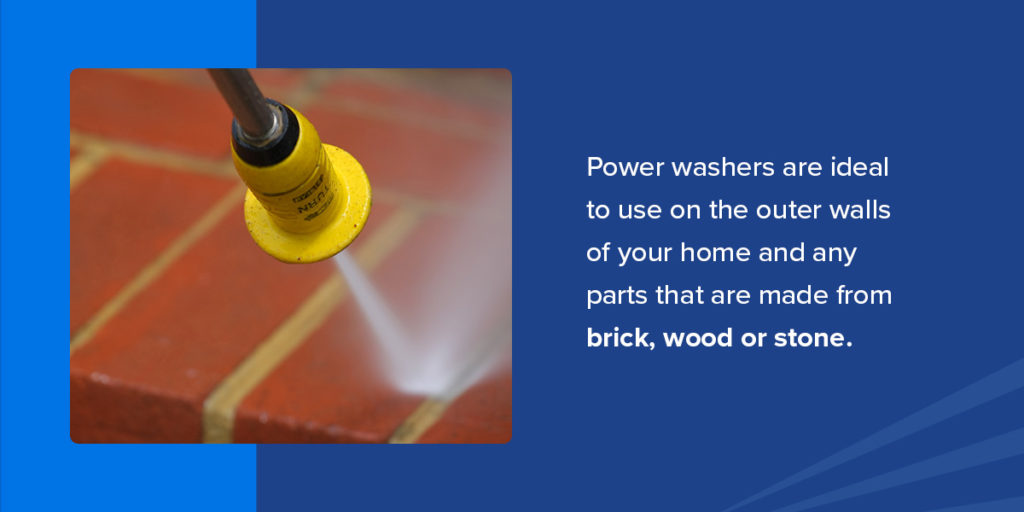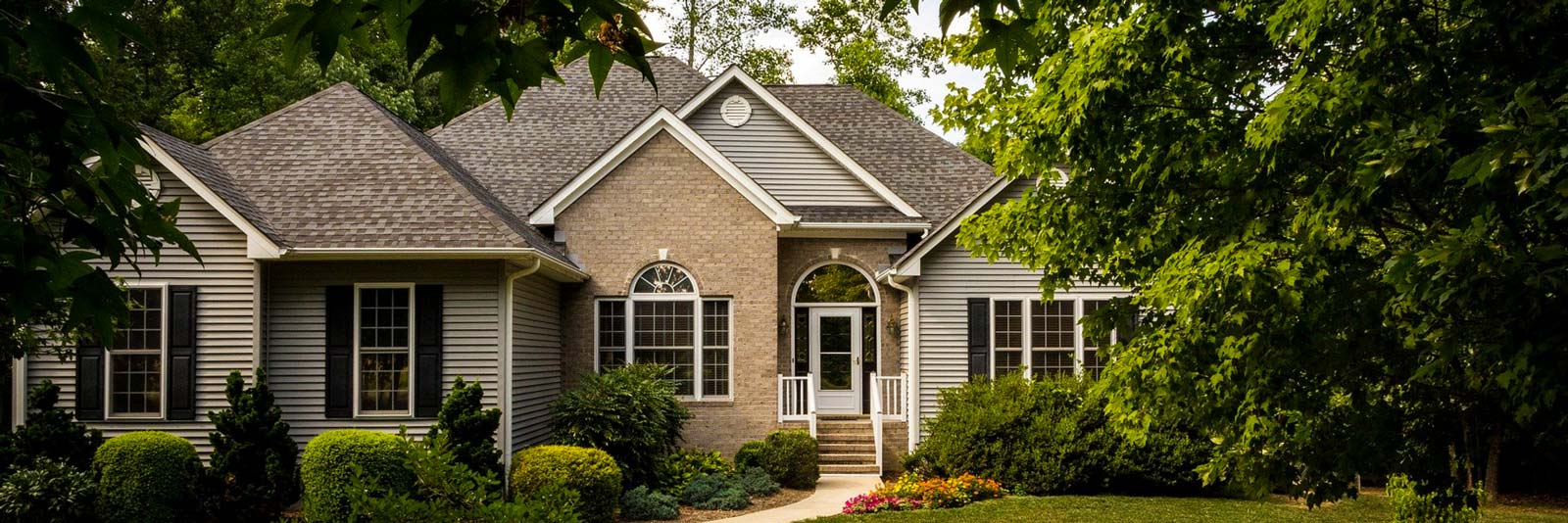Whether you have owned a home for 40 years or just bought your first home, naming the various common parts of a house exterior can be challenging. Well, we are here to help. As an exterior cleaning company with 20+ years of experience, our team of professionals at Perfect Power Wash knows a thing or two about the outside of homes.
Below we listed all the common terms associated with the various parts of a house exterior. We have listed them in alphabetical order, so you can use it as a glossary and find what you are looking for right away.

All the Parts of a House Exterior
Box End
Box ends of a home are located at the gables, generally where the siding and roof line meet. They create a better appearance and seal in the areas where the siding and roof meet.
Chimney
Chimneys are designed to aid in the release of smoke and toxic gasses from the interior of a home. They are primarily attached to the fireplace and built vertically to push the hot fumes upward and out of the home.
Column
Columns are typically located at the face of the home. Coming in multiple styles, columns are used for structural soundness, as well as a decorative touch.
Corner Post
Corner posts are constructed at a 90-degree angle and located on the corners of homes and garages. Typically made of aluminum, they are designed to protect the attached corners from damage and support the corner structurally.
Drip Edge
Drip edges are located underneath the edge of a roof line near the gutters. They are designed to protect the roof by letting rainwater at the edge of the roof work its way into the gutters.
Driveway
The gateway to your home, the driveway brings you from the street to your front doorstep. Driveways are generally comprised of concrete or asphalt, though different types of concrete and gravel are relatively common.

Dormer
Dormers are located along the angle of a roof and contain windows. Dormers generally encapsulate areas like attics on the higher levels of a home.
Downspouts
Downspouts are attached at the ends of gutters and move vertically down the edges of a home. These aluminum tubes direct water down the side of the home and away from the foundation.
Eave
An eave is the part of the roof that hangs over the side of the home. Otherwise known as an overhang, eaves are designed to push water clear of the siding.
Fascia
The fascia is located at the point where the gutter and roofline meet. They are generally made of aluminum and wood.
Flashing
Flashing is usually located on several areas of a home. It is designed to direct water away from vulnerable areas within the home’s exterior.
Foundation
Foundations are found at the base of a home at ground level. They are specifically designed to bear the weight of the home and provide strength and stability.
Frieze Board
Frieze board is trim installed where the siding meets the soffits. It is generally horizontal and placed at the very top end of the siding under the edge of the roof.
Gable
Gables are two sloping sections of a roof that come together to create a peak. They are used as an aesthetic element.
Garage
Attached or detached, garages are used for parking cars and general storage.
Gutters
Typically made of aluminum, gutters are found along the perimeter of a house. This piece collects rainwater, leads it to downspouts, and away from the home.
Note: Gutter guards are becoming a popular feature on the exterior of homes. Typically made of stainless steel, this piece covers your gutters and prevents gutters from clogging due to leaves, twigs, and samaras (helicopters).
Hip
A hip is a connecting point between two different sides of a roof that slope downward.
Patio
Patios are outdoor spaces that are commonly comprised of a type of concrete. They are typically adjoined to the house.
Porch
A porch is generally at the front entrance of a home and sheltered by a roof or eaves. Porches can also be in the back of homes, similar to patios, and be used as entertainment areas.
Railing
Railings are located in spots like the sides of steps and around the outside of a deck. They are used as a border and safety precaution.
Rake
Rake is the term used for the sloped sides on the end of a gabled roof.
Ridge
A ridge is a peak on a roof where two sloping sides meet. Ridge is also the term for the beam used to build this part of the roof.
Sidewalks
Sidewalks are typically made of concrete and create paths to various areas on the outside of a home.
Soffit
Soffits are made of vinyl, wood, and most commonly aluminum. They are attached under roof overhangs to protect the tresses that hang over the side of a home or to cover porch ceilings. Soffits are often vented to allow airflow into your attic.
Steps
Steps are generally located at the ends of porches and decks to help people reach a surface that is either above or below them.
Shingles
Shingles cover a roof and are generally made of asphalt and limestone. They are nailed and overlap to protect your home from weather elements.
Siding
Siding is the term for the exterior walls of the home. The most common types are vinyl, aluminum, and brick.
Vents
Vents are located in different spots on a roof and allow air to escape from a home.
Windows/Doors
Windows are strategically installed on a home to allow light inside and provide views outside. They are typically fitted with glass. Doors, either hinged or sliding, allow people to enter and exit a home. Here are a few features that relate to them.
- Apron
- An apron is a decorative trim beneath a window and against the siding.
- Grid
- A window grid is created by materials laid within the glass of a window to create the look of multiple panes. Grids can also be placed on the exterior of a window. Depending on how grids are installed, they can either be decorative or supportive in nature.
- Header
- Headers are trim boards above doors/windows that are both decorative and built for supporting the weight above it.
- Shutters
- Shutters are located on the left and right sides of windows. While they originally were a functional piece to protect homes from storms, today they are more commonly decorative and often have no functionality.
- Trim
- Trim comes in many forms such as vinyl, wood, and aluminum. It borders windows and doors both on interiors and exteriors to help improve aesthetics.

Effective Techniques for Cleaning Exteriors Parts of Your Home
Different parts of your house’s exterior require different tools, as some cleaning methods are too harsh to use for certain areas and can cause damage to delicate components. Knowing the anatomy of a house’s exterior and where to use specific tools will help you achieve a thorough clean while preserving the integrity of your home.
Parts You Can Power Wash

We advise power washing for sturdier parts of your house that can take the impact of high-pressure spray. Power washers are ideal to use on the outer walls of your home and any parts that are made from brick, wood or stone. This method also works well for washing your house’s garage doors and driveways — just keep the stream on sturdy parts with more surface area and less intricate designs or patterns.
Parts You Should Clean With a Garden Hose
A few common parts of a house’s exterior are too fragile for high-pressure cleaning, making them best suited for the lower pressure of a garden hose. For instance, a hose is ideal for giving your windows, deck and patio a good rinse to increase your house’s curb appeal. Some of these areas can tolerate a little more water pressure than others, so use different hose nozzles for various jobs to maximize this tool’s effectiveness.
Parts You Should Hand Scrub
When you’re deciding how to clean the exterior of your home, don’t discount scrubbing by hand. For spot-treating stains and giving delicate materials the care they deserve, turn to a mild dish soap and a scrub brush to break up grime and tackle stains that larger-scale cleaning methods might miss. Cleaning by hand is excellent for smaller jobs like washing grills, railings or trim areas. Incorporate this technique into your cleaning strategy and alternate between it and more aggressive tools to ensure you can tackle every area.
Other Cleaning Techniques
Use microfiber cloths with dish soap and water to effectively clean your glass surfaces like windows and doors. A squeegee is also useful in this application to prevent water spots during drying.
For cleaning the uppermost area of your home, tools like leaf blowers, brooms and scoops work well to clean your roof and gutters and minimize the chance of clogging. Make sure you follow safety precautions and do everything possible to prevent the chance of a fall, including setting your ladders securely and having a friend on hand to spot you. Many homeowners choose to have a professional service handle gutter cleaning and maintenance to keep fall risk to a minimum.
Get in Touch With the Perfect Power Wash Team
The many different parts of a home require a variety of cleaning techniques, but the sheer size of the exterior walls makes calling a professional power washing service the best way to save time and ensure a thorough clean. To learn more about how we can help you keep your house at its best, reach out for a quote online or call 888-868-8873.




